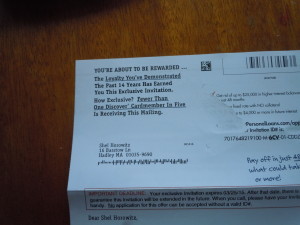Two Books That Changed My Life—And How I Seized an Opportunity

Photo by Jennifer Marr
As a new subscriber to John Corcoran’s newsletter and a constant reader, I followed John’s link to his list of 20 influential business books. It was a terrific list (I’ve read quite a few of them). And he got quite a few additional suggestions from readers. (Side note: sign of a successful post: 40+ comments, most of them recommendations.)
He has never heard from me. As far as know, he has no idea who I am. But I, of course, jumped in. I’d like you to read my comment in “learning mode,” think about what lessons you can pull from it, and post a comment on this page. THEN check out the lessons I think I’m imparting here, and comment again on that page. (You probably want to look at John’s list first.)
Hi, John, great list. I’m fairly new to your email tribe and this is the first time I’ve seen it. I’m a business book writer and an addicted reader (read about 70 books in the first 9 months of 2015) and was delighted to see how many I’ve read. I’ll look forward to listening to some of those podcasts. I’m listening to the interview with Dan Pink as I write this.
My own recommendations? Two in particular that no one else has mentioned:
1) The Success Principles by Jack Canfield and Janet Switzer. By far the best thing I’ve ever come across on personal motivation and the life hacks to build world-changing influence.
2) Cash Copy by Jeffrey Lant utterly changed the way I think about copywriting. Plenty of other books I’ve read since have a similar trajectory, but Cash Copy happened to be the one I read first–somewhere around 1988 or 1990. It turned me on to the whole idea of the you-focus of solving a pain point or helping the reader achieve a goal, rather than what I call “we we we all the way home copywriting” (e.g., “At _____ [company], we believe…”). That led me to develop “story-behind-the-story” marketing materials for my clients, such as a press release for a book on electronic privacy that used the headline, “It’s 10 O’Clock—Do You Know Where Your Credit History Is? (The book didn’t even get a mention until the third paragraph.)
I’ve been told by a number of people that my own Guerrilla Marketing Goes Green has opened them to the idea that green business is not just the right thing to do but can be quite profitable, thank you. I’m hoping my next book, Guerrilla Marketing to Heal the World, will broaden that discussion to show that turn hunger and poverty into sufficiency, war into peace, and catastrophic climate change into planetary balance. John, I’ll be in touch with you privately to see if you’d like an advance review copy.
—Shel Horowitz, https://impactwithprofit.com
Again, I invite you to post your immediate takeaways here. Then visit https://greenandprofitable.com/the-lessons-i-think-i-was-teaching to see if my intention matched your reaction, and post again over there. It may prove a fascinating and illuminating conversation—and give you lots of insight to use in your own marketing and customer relations.







